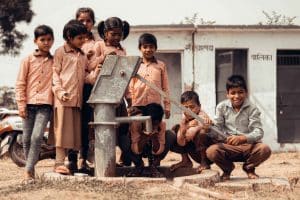The Pradhan Mantri Adarsh Gram Yojana (PMAGY) is a plan by the Indian government to help underprivileged communities. It wants to develop selected villages by combining different national and state programs.
An ‘Adarsh Gram’ is a village where everyone can easily get basic services, making sure that everyone’s basic needs are met, and differences between people are as small as possible.
The selected villages would have all the necessary facilities, and the people living there will be able to access essential services, creating an environment where everyone can make the most of their abilities.
The program started in March 2010 as a test for developing 1,000 villages, each with more than half of its population belonging to Scheduled Castes.

Table of Contents
Pradhan Mantri Adarsh Gram Yojana
In our country, Scheduled Castes (SCs) make up 16.6% of the population, as per the 2011 Census. SCs have faced challenges in social, educational, and economic spheres, leading to deprivation. To address this, the Constitution includes special provisions aimed at advancing their interests.
These provisions encompass actions to eliminate social hurdles, ensure equal opportunities, and implement positive measures for parity with the broader population.
The government has undertaken various initiatives for Scheduled Cast (SC) development, resulting in positive outcomes and reducing the gap between SCs and the rest of the population. However, most welfare schemes for SCs have primarily focused on individual beneficiaries rather than the holistic development of SC communities.
In pursuit of a regional development approach, a new scheme called the PMAGY was introduced on a pilot basis during 2009-2010.
The scheme aims at the integrated development of villages where the SC population exceeds 50%. A total of 1000 villages from Tamil Nadu (225), Rajasthan (225), Bihar (225), Himachal Pradesh (225), and Assam (100) were selected for the pilot phase (I-Phase).
Adarsh Gram Youana Vision
The concept of an “Adarsh Gram” envisions a place where people can access essential services, ensuring the basic needs of all societal sections are fully satisfied and disparities are minimized.
These villages should possess the necessary infrastructure, providing residents with access to fundamental services crucial for dignified living. This creates an environment where everyone can fully utilize their potential.
The primary aim of this scheme is to ensure the comprehensive development of selected villages with over 50% Scheduled Caste (SC) population. This includes:
Adequate Infrastructure
The scheme intends to provide all essential infrastructure necessary for socio-economic development in these villages.
Improvement in Socio-Economic Indicators
The scheme targets the enhancement of identified socio-economic indicators, also known as Monitorable Indicators. The goal is to eliminate the disparity between SC and non-SC populations, raising the indicators to at least the national average.
Specific objectives include ensuring food and livelihood security for all Below Poverty Line (BPL) SC families, promoting education completion up to the secondary level for all SC children, addressing factors contributing to maternal and infant mortality, and eliminating malnutrition, especially among children and women.
The scheme envisions these villages to be equipped with all necessary facilities for dignified living, fostering an environment where residents can fully realize their potential. Compliance with specified norms is essential for achieving these objectives.
Also Read: Government Schemes for Scheduled Caste Community
PMAY Scheme Objectives
The objectives of the scheme are:
Physical Infrastructure
- The village should be connected to the nearest major road with an all-weather road. In multi-hamlet villages, ensure all hamlets are interconnected with all-weather roads.
- Ensure sustainable access to safe drinking water for all.
- All houses in the village should be provided with electricity.
- Maintain slush-free internal roads and provide adequate street lighting.
- Establish communication facilities like post offices, telephones, internet (if possible), and Bharat Nirman Common Service Centers (established by the Department of Information Technology).
- Ensure accessible banking facilities through regular branches or the Business Correspondent/Business Facilitator Model.
- Ensure all residents have adequate housing, and no families are homeless.
Sanitation and Environment
- There should be high sanitation standards in the village, eliminating dry latrines, open defecation, and ensuring sanitary toilets, drains, and an efficient waste disposal system. Aim to fulfill “Nirmal Gram Puraskar” norms.
- The village should care for the environment through tree planting, water harvesting, maintenance of water bodies, and the use of renewable energy sources such as biogas, solar energy, wind energy, and smokeless chulhas.
Social Infrastructure, Human Development, and Social Harmony
- An Anganwadi centre and a school of appropriate level should have there in the village.
- Provide adequate and attractive buildings for Anganwadi, schools, health centers, panchayats, and community halls.
- Develop facilities for sports and other physical activities for the village people.
- Enroll and ensure regular attendance of children aged 3-6 in Anganwadi and children aged 6-14 in school.
- Promote functional literacy among adults and provide access to continuing education facilities.
- Ensure access to primary health care and Reproductive Child Health (RCH) facilities, with proper pre-natal and ante-natal care for mothers.
- Aim for 100% institutional deliveries, full immunization of children, and adherence to the small family norm.
- Foster community care for women, children (especially girls), senior citizens, and persons with disabilities.
- Discourage public consumption of liquor or intoxicating substances in the Adarsh Gram
- Encourage the active participation of the village in Gram Sabha/Gram Panchayat, women’s/swarojgaris’ self-help groups, youth clubs, and mahila mandals.
- Eliminate caste-based discrimination, eradicate untouchability, and ensure a sense of security and dignity among the weaker sections.
Adarsh Gram Yojana Village List
The number of villages selected for the phase I of PMAGY yojana are as under
|
S.No. |
State Name |
No. of Selected Villages | No of Villages declared Adarsh Gram | Total Fund Released |
| 1 | Himachal Pradesh | 225 | 225 | 45.225 Crore |
| 2 | Tamil Nadu | 225 | 225 | 45.225 Crore |
| 3 | Bihar | 225 | 225 | 45.225 Crore |
| 4 | Rajasthan | 225 | 225 | 45.225 Crore |
| 5 | Assam | 100 | 100 | 20.10 Crore |
| Total | 1000 | 1000 | 201.06 Crore | |
The number of villages picked under the scheme’s second phase are as under:
|
S.No. |
State/UT Name |
No of Villages Eligible for II-Phase | Villages Already Covered Under Previous Phases | No. of Villages Selected | Remaining Villages to be Covered | Fund Released by the Govt. |
| 1 | Maharashtra | 227 | 0 | 207 | 70 | 2177.20 |
| 2 | Manipur | 16 | 0 | 16 | 0 | 332.80 |
| 3 | Meghalaya | 4 | 0 | 4 | 0 | 41.60 |
| 4 | Odisha | 994 | 131 | 812 | 134 | 4605.60 |
| 5 | Puducherry | 10 | 0 | 10 | 0 | 167.45 |
| 6 | Punjab | 2097 | 152 | 825 | 1120 | 3709.80 |
| 7 | Rajasthan | 1415 | 140 | 1040 | 235 | 15254.0 |
| 8 | Tamil Nadu | 2044 | 212 | 477 | 1355 | 5043.80 |
| 9 | Telangana | 169 | 5 | 169 | 0 | 3210.70 |
| 10 | Tripura | 31 | 0 | 31 | 0 | 624 |
| 11 | Utter Pradesh | 6394 | 221 | 3744 | 2448 | 23935.35 |
| 12 | Uttarakhand | 212 | 0 | 244 | 68 | 3095.20 |
| 13 | West Bengal | 5617 | 0 | 0 | 5617 | 0.00 |
| 14 | Andhra Pradesh | 495 | 6 | 440 | 53 | 8448.40 |
| 15 | Assan | 617 | 131 | 441 | 45 | 5190.00 |
| 16 | Bihar | 1456 | 128 | 616 | 712 | 6513.60 |
| 17 | Chhattisgarh | 769 | 127 | 537 | 115 | 990.20 |
| 18 | Gujrat | 25 | 0 | 25 | 0 | 520.00 |
| 19 | Haryana | 366 | 11 | 290 | 76 | 4314.40 |
| 20 | Himachal Pradesh | 417 | 60 | 308 | 49 | 4427.60 |
| 21 | Jammu & Kashmir | 261 | 0 | 261 | 0 | 2790.40 |
| 22 | Jharkhand | 720 | 96 | 512 | 156 | 2791.70 |
| 23 | Karnataka | 1315 | 165 | 1085 | 90 | 11665.00 |
| 24 | Kerala | 1 | 0 | 1 | 0 | 21.20 |
| 25 | Madhya Pradesh | 1146 | 124 | 1033 | 56 | 15972.50 |
| Total | 134842.50 | |||||
PMAGY Scheme’s Expansion
Considering the positive impact experienced by village residents due to the successful execution of the Scheme, a decision was made in the fiscal year 2018-19 to extend its reach in Phase-II.
Districts eligible for consideration are those containing villages with a total population of ≥500 and where over 50% of the residents belong to the Scheduled Castes.
The proposed approach involves selecting villages in descending order of SC population from each district for the new phase of Scheme implementation. The Government of India aims to encompass all 26,968 eligible villages by the end of 2025.
Scheme Monitoring
The scheme outlines the establishment of committees at different levels to guide, monitor, and implement the project. Among these, the Convergence Committees at the Village, District, and State levels play a vital role.
They are essential for assessing requirements and planning and executing the necessary works and services under various schemes, ensuring the comprehensive development of villages.
The Government of India has devised a clear structure for planning, implementing, and monitoring the execution of the scheme.
A user-friendly website has been activated, allowing the collection of household-level data, assessment of village needs, prioritization of works, preparation of the Village Development Plan, and regular monitoring of the scheme.
Conclusion
The Pradhan Mantri Adarsh Gram Yojana (PMAGY) stands as a pivotal initiative in India’s quest for inclusive development. Launched as a pilot project in 2009-10, PMAGY targets villages with over 50% Scheduled Caste population, aiming at integrated and holistic progress.
The scheme focuses on essential aspects like infrastructure, socio-economic indicators, sanitation, environment, and social harmony. Its expansion in Phase-II reflects the positive impact witnessed in villages, reinforcing the government’s commitment to uplifting marginalized communities.
The scheme’s success is contingent on its structured approach, involving committees at various levels for effective planning and execution. By prioritizing simplicity and grassroots empowerment, PMAGY embodies a grassroots-driven vision, contributing to the nation’s pursuit of balanced and equitable growth.


